Caen
Caen (/kɒ̃, kɑːn/, French: [kɑ̃] (![]()
Caen | |
|---|---|
Prefecture and commune | |
July 2010 view of centre of Caen and the Abbey of St. Étienne | |
2.svg.png) Coat of arms | |
Location of Caen 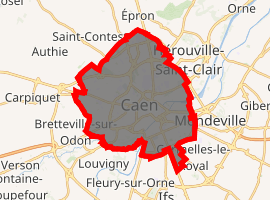
| |
 Caen  Caen | |
| Coordinates: 49°11′N 0°22′W | |
| Country | France |
| Region | Normandy |
| Department | Calvados |
| Arrondissement | Caen |
| Canton | Caen-1, 2, 3, 4 and 5 |
| Intercommunality | Caen la Mer |
| Government | |
| • Mayor (2014–2020) | Joël Bruneau (LR) |
| Area 1 | 25.70 km2 (9.92 sq mi) |
| Population (2017-01-01)[1] | 105,354 |
| • Density | 4,100/km2 (11,000/sq mi) |
| Demonym(s) | Caennais |
| Time zone | UTC+01:00 (CET) |
| • Summer (DST) | UTC+02:00 (CEST) |
| INSEE/Postal code | 14118 /14000 |
| Elevation | 2–73 m (6.6–239.5 ft) (avg. 8 m or 26 ft) |
| Website | www.caen.fr |
| 1 French Land Register data, which excludes lakes, ponds, glaciers > 1 km2 (0.386 sq mi or 247 acres) and river estuaries. | |
It is located 15 kilometres (9.3 miles) inland from the English Channel, 200 kilometres north-west of Paris, and connected to the south of England by the Caen-(Ouistreham)-Portsmouth ferry route. Caen is located in the centre of its northern region, and it is a centre of political, economic and cultural power. Located a few miles from the coast, the landing beaches, the bustling resorts of Deauville and Cabourg, as well as Norman Switzerland and Pays d'Auge, Caen is often considered the archetype of Normandy.
Caen is known for its historical buildings built during the reign of William the Conqueror, who was buried there, and for the Battle for Caen—heavy fighting that took place in and around Caen during the Battle of Normandy in 1944, destroying much of the city. The city has now preserved the memory by erecting a memorial and a museum dedicated to peace, the Mémorial de Caen.
Symbols
Heraldry
Current arms:
Gules, a single-towered open castle Or, windowed and masoned sable.
Under the Ancien Régime: Per fess, gules and azure, 3 fleurs de lys Or.
During the First French Empire: Gules, a single-towered castle Or, a chief of Good Imperial Cities (gules, 3 bees Or).

Arms in effect under Ancien Régime. 
_Empire_(Orn_ext).svg.png)
Arms in effect under the First French Empire. _(Orn_ext).svg.png)
Arms in effect today, reverting to the original arms of the 13th century.
Motto
Today, Caen has no motto, but it used to have one, which did not survive the French Revolution. As a result, its spelling is archaic and has not been updated:[5]
Un Dieu, un Roy, une Foy, une Loy.
(One God, one King, one Faith, one Law.)
This motto is reflected in a notable old Chant royal.[6]
Code
Caen's home port code is CN.
History
Early history
Caen was known in Roman times as 'Catumagos', from the Gaulish roots magos meaning 'field' and catu meaning 'combat'. It remained a minor settlement throughout the Roman period and began to see major development commence in the 10th century, under the patronage of the Dukes of Normandy. Around 1060, William the Conqueror began construction of the Château de Caen, which became the centre of the ducal court. Duchess Matilda of Flanders also founded the Benedictine Abbey of Sainte-Trinité, Caen around the same time, eventually being buried in the abbey. Caen succeeded Bayeux as the capital of Lower Normandy, complementing the second ducal capital of Rouen.
Caen fell to Philip II of France on 21 May 1204, and was incorporated along with the remainder of Normandy into the Kingdom of France.
Hundred Years' War
In 1346, King Edward III of England led his army against the city, hoping to loot it. It was expected that a siege of perhaps several weeks would be required, but the army took the city in less than a day, on 26 July 1346, storming and sacking it, killing 3,000 of its citizens, and burning much of the merchants' quarter on the Ile Ste-Jean. Only the castle of Caen held out, despite attempts to besiege it. A few days later, the English left, marching to the east and on to their victory at the Battle of Crécy. It was later captured following a siege by Henry V in 1417 and treated harshly for being the first town to put up any resistance to his invasion. In 1450 towards the end of the war, French forces recaptured Caen.
Second World War

During the Battle of Normandy in the Second World War, Caen was liberated from the Nazis in early July, a month after the Normandy landings, particularly those by British I Corps on 6 June 1944. British and Canadian troops had intended to capture the town on D-Day. However they were held up north of the city until 9 July, when an intense bombing campaign during Operation Charnwood destroyed 70% of the city and killed 2,000 French civilians.[7] The Allies seized the western quarters, a month later than Field Marshal Montgomery's original plan. During the battle, many of the town's inhabitants sought refuge in the Abbaye aux Hommes ("Men's Abbey"), built by William the Conqueror some 800 years before. The spire of the Church of Saint-Pierre, Caen and the university were destroyed by the British and Canadian bombing.
Post-war
Post-Second World War work included the reconstruction of complete districts of the city and the university campus. It took 14 years (1948–1962) and led to the current urbanization of Caen. Having lost many of its historic quarters and its university campus in the war, the city does not have the atmosphere of a traditional Normandy town such as Honfleur, Rouen, Cabourg, Deauville and Bayeux.
The Canadian Army Film and Photo Unit filmed the D-Day offensive and Orne breakout several weeks later, then returned several months later to document the city's recovery efforts. The resulting film, You Can't Kill a City, is preserved in the National Archives of Canada.
Images
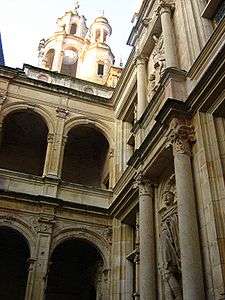 Hôtel d'Escoville, 16th century, Caen
Hôtel d'Escoville, 16th century, Caen Anonymous pen-and-ink bird's-eye view of the fortifications of Caen (Bibliothèque Nationale, Paris)
Anonymous pen-and-ink bird's-eye view of the fortifications of Caen (Bibliothèque Nationale, Paris) South Wall of the Castle, a huge fortress in the centre of the city
South Wall of the Castle, a huge fortress in the centre of the city- Town Hall of Caen
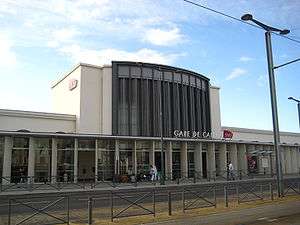 Caen railway station
Caen railway station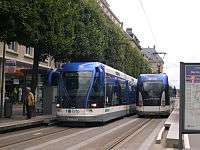 Caen's former 'tramway' was in fact a modern guided-bus system. A new tramway is going to be launch in September 2019.
Caen's former 'tramway' was in fact a modern guided-bus system. A new tramway is going to be launch in September 2019. Saint-Étienne-le-Vieux Church
Saint-Étienne-le-Vieux Church- Interior of Saint-Pierre Church
- The fortress of Caen
- The Abbey of St. Étienne
 Église Saint Pierre seen from in front of the Château
Église Saint Pierre seen from in front of the Château
Etymology
The very first mentions of the name of Caen are found in different acts of the dukes of Normandy: Cadon 1021/1025,[8] Cadumus 1025,[9] Cathim 1026/1027.[10] Year 1070 of the Parker manuscript[11] of the Anglo-Saxon Chronicle refers to Caen as Kadum,[12] and year 1086 of the Laud manuscript[13] gives the name as Caþum.[14] Despite a lack of sources as to the origin of the settlements, the name Caen would seem to be of Gaulish origin, from the words catu-, referring to military activities and magos, field, hence meaning "manoeuvre field" or "battlefield".[15] In Layamon's Brut, the poet asserts that King Arthur named the city in memory of Sir Kay.[16]
Geography
Caen is in an area of high humidity. The Orne River flows through the city, as well as small rivers known as les Odons, most of which have been buried under the city to improve urban hygiene. Caen has a large flood zone, named "La prairie", located around the hippodrome, not far from the River Orne, which is regularly submerged.[17][18]
Caen is 10 km (6 mi) from the Channel. A canal (Canal de Caen à la Mer) parallel to the Orne was built during the reign of Napoleon III to link the city to the sea at all times. The canal reaches the English Channel at Ouistreham. A lock keeps the tide out of the canal and lets large ships navigate up the canal to Caen's freshwater harbours.
Climate
Caen has an oceanic climate that is somewhat ameliorated due to its slightly inland position. In spite of this, summers are still cool by French standards and the climate is typically maritime in terms of high precipitation, relatively modest sunshine hours and mild winters.
| Climate data for Caen (CFR), elevation: 67 m (220 ft), 1981–2010 normals, extremes 1945–present | |||||||||||||
|---|---|---|---|---|---|---|---|---|---|---|---|---|---|
| Month | Jan | Feb | Mar | Apr | May | Jun | Jul | Aug | Sep | Oct | Nov | Dec | Year |
| Record high °C (°F) | 16.1 (61.0) |
20.8 (69.4) |
24.4 (75.9) |
26.6 (79.9) |
30.4 (86.7) |
35.2 (95.4) |
39.7 (103.5) |
38.9 (102.0) |
33.5 (92.3) |
28.9 (84.0) |
21.6 (70.9) |
17.2 (63.0) |
39.7 (103.5) |
| Average high °C (°F) | 8.0 (46.4) |
8.6 (47.5) |
11.5 (52.7) |
13.6 (56.5) |
17.1 (62.8) |
20.1 (68.2) |
22.6 (72.7) |
22.8 (73.0) |
20.1 (68.2) |
16.1 (61.0) |
11.5 (52.7) |
8.3 (46.9) |
15.1 (59.2) |
| Daily mean °C (°F) | 5.3 (41.5) |
5.5 (41.9) |
7.8 (46.0) |
9.5 (49.1) |
12.8 (55.0) |
15.8 (60.4) |
17.8 (64.0) |
18.0 (64.4) |
15.6 (60.1) |
12.4 (54.3) |
8.4 (47.1) |
5.7 (42.3) |
11.2 (52.2) |
| Average low °C (°F) | 2.6 (36.7) |
2.4 (36.3) |
4.2 (39.6) |
5.3 (41.5) |
8.5 (47.3) |
11.0 (51.8) |
13.1 (55.6) |
13.2 (55.8) |
11.1 (52.0) |
8.7 (47.7) |
5.3 (41.5) |
3.0 (37.4) |
7.4 (45.3) |
| Record low °C (°F) | −19.6 (−3.3) |
−16.5 (2.3) |
−7.4 (18.7) |
−5.7 (21.7) |
−0.8 (30.6) |
1.0 (33.8) |
4.7 (40.5) |
4.0 (39.2) |
1.8 (35.2) |
−3.7 (25.3) |
−6.8 (19.8) |
−11.0 (12.2) |
−19.6 (−3.3) |
| Average precipitation mm (inches) | 66.1 (2.60) |
52.4 (2.06) |
55.6 (2.19) |
50.4 (1.98) |
62.6 (2.46) |
57.9 (2.28) |
52.6 (2.07) |
51.2 (2.02) |
60.8 (2.39) |
77.6 (3.06) |
74.6 (2.94) |
78.1 (3.07) |
739.9 (29.13) |
| Average precipitation days (≥ 1.0 mm) | 12.0 | 10.7 | 10.8 | 10.3 | 10.2 | 8.2 | 8.0 | 7.6 | 9.5 | 12.1 | 12.7 | 13.6 | 125.7 |
| Average snowy days | 3.4 | 3.8 | 2.3 | 0.9 | 0.1 | 0.0 | 0.0 | 0.0 | 0.0 | 0.0 | 0.9 | 2.2 | 13.6 |
| Average relative humidity (%) | 86 | 84 | 82 | 80 | 81 | 82 | 81 | 81 | 83 | 86 | 86 | 87 | 83 |
| Mean monthly sunshine hours | 69.6 | 84.3 | 125.6 | 167.3 | 193.7 | 213.5 | 207.1 | 204.4 | 167.2 | 117.8 | 79.4 | 61.4 | 1,691.2 |
| Source 1: Meteo France[19][20] | |||||||||||||
| Source 2: Infoclimat.fr (relative humidity 1961–1990)[21] | |||||||||||||
Main sights
Castle
The castle, Château de Caen, built circa 1060 by William the Conqueror, who successfully conquered England in 1066, is one of the largest medieval fortresses of Western Europe. It remained an essential feature of Norman strategy and policy. At Christmas 1182, a royal court celebration for Christmas in the aula of Caen Castle brought together Henry II and his sons, Richard the Lionheart and John Lackland, receiving more than a thousand knights. Caen Castle, along with all of Normandy, was handed over to the French Crown in 1204. The castle saw several engagements during the Hundred Years' War (1346, 1417, 1450) and was in use as a barracks as late as the Second World War. Bullet holes are visible on the walls of the castle where members of the French Resistance were shot during the Second World War. Today, the castle serves as a museum that houses the Musée des Beaux-Arts de Caen (Museum of Fine Arts of Caen) and Musée de Normandie (Museum of Normandy) along with many periodical exhibitions about arts and history. (See "Timeline of Caen Castle". Archived from the original on 13 February 2006. Retrieved 28 August 2004.)
Abbeys
In repentance for marrying his cousin Mathilda of Flanders, William ordered two abbeys to be built on the Pope's encouragement:
- Eglise St.-Etienne, formerly the Abbaye aux Hommes (Men's Abbey). It was completed in 1063 and is dedicated to St Stephen. The current Hôtel de Ville (town hall) of Caen is built onto the South Transept of the building.
- Eglise de la Ste.-Trinité, formerly the Abbaye aux Dames (Women's Abbey). It was completed in 1060 and is dedicated to the Holy Trinity. The current seat of the regional council (conseil régional) of Basse-Normandie is nearby.
Others
- Jardin botanique de Caen, a historic botanical garden
- Church of Saint-Pierre
- Church of Saint-Étienne-le-Vieux
- Mémorial pour la Paix ("Memorial for Peace") built in 1988, charting the events leading up to and after D-Day. It is an emotional presentation inviting meditation on the thought of Elie Wiesel: "Peace is not a gift from God to man, but a gift from man to himself". The Memorial for Peace also includes an exhibit of Nobel Peace Prize winners and another one on Conflict Resolution in different cultures.
- Parc Festyland, an amusement park to the west of Caen in the nearby town of Carpiquet. The park receives 110,000 visitors every year.
- Mondeville 2 is a regional shopping centre in adjoining Mondeville.
- Medieval wooden houses[22]
- Colline aux Oiseaux, a floral parc located on the former dump of the city of Caen[23][24]
Administration
Mayors of Caen have included:
- 1945–1959 : Yves Guillou, Rally of the French People
- 1959–1970 : Jean-Marie Louvel, MRP and Centre Démocrate
- 1970–2001 : Jean-Marie Girault, Republican Party and UDF
- 2001–2008 : Brigitte Le Brethon, RPR and UMP
- 2008–2014 : Philippe Duron, PS
- 2014–present : Joël Bruneau, The Republicans
In 1952, the small commune of Venoix became part of Caen.
In 1990, the agglomeration of Caen was organized into a district, transformed in 2002 into a Communauté d'agglomération (Grand Caen (Greater Caen), renamed Caen la Mer in 2004), gathers 29 towns and villages, including Villons-les-Buissons, Lion-sur-Mer, Hermanville-sur-Mer, which joined the Communauté d'agglomération in 2004. The population of the "communauté d'agglomération" is around 220000 inhabitants.
In the former administrative organisation, Caen was a part of 9 cantons, of which it was the chief town. These cantons contained a total of 13 towns. Caen gave its name to a 10th canton, of which it was not part. Since the 2015 canton reorganization, Caen is part of the cantons of Caen-1, 2, 3, 4 and 5.[25]
Transport
Formerly, Caen had guided bus system—built by Bombardier Transportation and modelled on its Guided Light Transit technology. Faced with the residents' anger against the project, the municipality had to pursue the project with only 23% of the population in favour of the new form of transport. The road layout of the city centre was deeply transformed and the formerly traffic-jam-free centre's problems are still unresolved. The system was closed in 2017 to make way for a new tram network that was opened in 2019. The new tramway was inaugurated in 27 July 2019.[26]
Caen also has a very efficient network of city buses, operated under the name Twisto. The city is connected to the rest of the Calvados département by the Bus Verts du Calvados bus network.
Caen - Carpiquet Airport is the biggest airport in Normandy considering the number of passengers and flights that it serves every year. Most flights are operated by HOP! and Chalair Aviation, Volotea and the French national airline Air France operates three daily flights to the French cities of Lyon and Marseille. In the summer there are many flights to Spain, Germany, Tunisia, Morocco and Algeria.
Caen is served by the large port of Ouistreham, lying at the mouth of the Caen Canal where it meets the English Channel. A cruise/ferry service operates between Portsmouth, England, and Caen/Ouistreham running both standard roll-on-roll-off car ferries and supercat fast ferries, with the latter making crossing from March to November. The ferry terminal is 15 km (9.3 mi) from Caen with a daytime shuttle bus service for foot passengers. There's also a cyclist road from Caen to Ouistreham.[27]
Caen is connected to the rest of France by motorways to Paris (A13), Brittany and Southern France (A84) and to Le Mans and central France (A88–A28). The A13 and A88 are toll roads while the A84 is a toll-free motorway. The city is encircled by the N814 ring-road (Boulevard Périphérique) that was completed in the late 1990s. The N13 connects Caen to Cherbourg and to Paris. A section of the former N13 (Caen-Paris) is now D613 (in Calvados) following road renumbering. The Boulevard Périphérique includes an impressive viaduct called the Viaduc de Calix that goes over the canal and River Orne. The canal links the city to the sea to permit cargo ships and ferries to dock in the port of Caen. Ferries which have docked include the Quiberon and the Duc de Normandie.
Although a fraction of what it used to be remains, Caen once boasted an extensive rail and tram network. From 1895 until 1936, the Compagnie des Tramways Electriques de Caen (Electrical Tramway Company of Caen) operated all around the city. Caen also had several main and branch railway lines linking Caen railway station to all parts of Normandy with lines to Paris, Vire, Flers, Cabourg, Houlgate, Deauville, Saint-Lô, Bayeux and Cherbourg. Now only the electrified line of Paris-Cherbourg, Caen-Le Mans and Caen-Rennes subsist with regular services.
Education
- The University of Caen has around 30,000 students in five different campuses. The University is divided into 11 colleges, called UFR (Unité fondamentale de Recherche), six institutes, one Engineering School, two IUP and five local campuses. The University is one of the oldest in France, having been founded by Henry VI, King of England in 1432.
- Caen also has a school of fine arts (L'ésam Caen/Cherbourg) and grandes écoles such as the École nationale supérieure d'ingénieurs de Caen.
- A campus of the business school École de management de Normandie is also located in the city.

Economy
The agricultural and food-processing Agrial cooperative has its head office on Caen. Agrial group processes vegetables, cider apples, milk, poultry and meat with the help of its 12,000 employees and all its partners.[28]
Music and theatre
The Théâtre de Caen (1963) is the home of the Baroque musical ensemble Les Arts Florissants. The organization was founded by conductor William Christie in 1979 and derives its name from the 1685 opera by Marc-Antoine Charpentier.
Notable Caennais
Caen was the birthplace of:
- Sophie, Emmett (c. 1998–), student at King's College London, environmentalist
- Robert, 1st Earl of Gloucester (c. 1090–1147), illegitimate son of Henry I of England
- Robert Constantin (bibliographer) (1530?–1605), scholar, lexicographer
- Jean Bertaut (1552–1611), poet
- François le Métel de Boisrobert (1592–1662), poet
- François de Malherbe (1555–1628), poet, critic and translator (Malherbe's birthplace has survived)
- Tanneguy Le Fèvre (1615–1672), classical scholar
- Jean Regnault de Segrais (1624–1701), poet and novelist
- Pierre Daniel Huet (1630–1721), churchman and scholar
- René Auguste Constantin de Renneville (1650–1723), writer
- Pierre Varignon (1654–1722), mathematician
- Charlotte Corday (d. 1793), assassin of Marat
- François Henri Turpin (1709–1799), man of literature
- Jacques Clinchamps de Malfilâtre (1732–1767), poet
- J. Hector St. John de Crèvecœur (1735–1813), French-American writer
- Jean-Jacques Boisard (1744–1833), writer who specialized in fables
- Gervais de La Rue (1751–1835), historian
- Jean-François Boisard (1762–1820), painter
- Louis Gustave le Doulcet, comte de Pontécoulant (1764–1853), politician
- Daniel Auber (1782–1871), composer
- Jacques Amand Eudes-Deslongchamps (1794–1867), French naturalist and palaeontologist
- Étienne Mélingue (1808–1875), actor and sculptor
- Jules Danbé (1840–1905) opera conductor
- Charles-Hippolyte Pouthas (1886–1974), historian
- André-Louis Danjon (1890–1967), astronomer
- Marie-Pierre Kœnig (1898–1970), general who commanded a Free French Brigade at the Battle of Bir Hakeim in 1942, Maréchal de France
- Florent Chopin (born 1958), painter
- Christophe Desjardins (born 1962), violist
- Arnaud Guillon (1964– ), writer
- Gilles Peterson (1964– ), British-based DJ, record collector and record label owner, residing in London
- Sonia de La Provôté (1968– ), member of the French Senate
- Fabrice Le Vigoureux (1969– ), member of the National Assembly
- Laurent Lefrançois (1974–) French contemporary composer
- Joël Thomas (1987– ), professional football player
- Elliot Grandin (1987– ), professional football player
- Gabriel Dupont (1878–1914), musical composer
Saint John Eudes, the forerunner of the devotion to the Sacred Heart, died here.[29]
International relations
Twin towns – sister cities
Caen is twinned with:[30]


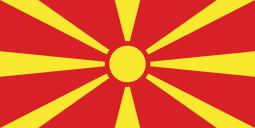




Sport
From 1947 to 2006, Caen was a stage of the Tour de France a total of 15 times.[31] Further, Caen was one of the hosts of the EuroBasket 1983. The city has a football team, SM Caen. In 2014, Caen was the location of the 2014 FEI World Equestrian Games.
See also
- Stade Malherbe Caen, Caen's football team
- Caen Stone
- Operation Charnwood
- Operation Overlord
- Communes of the Calvados department
References
- "Populations légales 2017". INSEE. Retrieved 6 January 2020.
- "La Normandie compte 3 339 131 habitants" (in French). paris-normandie.fr. Retrieved 22 March 2018.
- "Grande Normandie : combien d'habitants dans votre commune ?" (in French). Retrieved 22 March 2018.
- Cabinet du maire de Caen
- "French motto and heraldry site". Archived from the original on 2 January 2009. Retrieved 23 November 2009.
- Royal Chant, Pierre Gringoire (1475–1539)
- "Mémorial des victimes civiles 1944 en Basse-Normandie". Crhq.cnrs.fr. Retrieved 12 March 2013.
- Marie Fauroux, Recueil des actes des ducs de Normandie (911–1066), Mémoires de la Société des antiquaires de Normandie XXXVI, Caen, 1961, p. 122, n° 32.
- Ibid., p. 130, n° 34.
- Villam que dicitur Cathim super fluvium Olne: the town called Cathim on the Orne river, ibid., p. 182, n° 58.
- "Manuscript A: The Parker Chronicle". Asc.jebbo.co.uk. 15 August 2007. Retrieved 7 July 2009.
- Her Landfranc se þe wæs abbod an Kadum com to Ængla lande: Here Lanfranc who was abbot at Caen came to England.
- Manuscript E: The Laud Chronicle – Asc.jebbo.co.uk
- He swealt on Normandige on þone nextan dæg æfter natiuitas sancte Marie. 7-man bebyrgede hine on Caþum æt sancte Stephanes mynstre: He [King William] died in Normandy on the day after the Nativity of St Mary and was buried in Caen, in St Stephen's Abbey
- René Lepelley, Dictionnaire étymologique des noms de communes de Normandie, P.U.C., Corlet, Caen, Condé-sur-Noireau, 1996)
- Brut, l. 13,936
- "La Prairie de Caen". CAEN (in French). Retrieved 23 March 2018.
- "EN IMAGES. Caen : inondations autour de la Prairie". Ouest-France.fr (in French). Retrieved 23 March 2018.
- "Climatological Information for Caen, France". Meteo France. 6 August 2019.
- "CAEN–CARPIQUET (14)" (PDF). Fiche Climatologique: Statistiques 1981–2010 et records (in French). Meteo France. Retrieved 6 August 2019.
- "Normes et records 1961–1990: Cain-Carpiquet (14) – altitude 67m" (in French). Infoclimat. Archived from the original on 12 March 2013. Retrieved 6 August 2019.
- "Maisons à pans de bois". Office de Tourisme de Caen (in French). Retrieved 23 March 2018.
- "Colline aux Oiseaux". CAEN (in French). Retrieved 23 March 2018.
- "La colline aux oiseaux, l'un des plus grand parc et jardins de Cae". Site officiel du tourisme dans le Calvados (in French). Retrieved 23 March 2018.
- "Décret n° 2014-160 du 17 février 2014 portant délimitation des cantons dans le département du Calvados | Legifrance". Retrieved 16 May 2017.
- https://www.urban-transport-magazine.com/en/t-day-in-caen-new-tramway-inaugurated/
- Voie Verte
- "Annual Report 2014" (PDF). Agrial Group. Archived from the original (PDF) on 5 March 2016. Retrieved 29 June 2014.
- Catholic Saints
- "Nouvelle coopération internationale pour Caen" (PDF). caen.fr (in French). CaenMag. 15 September 2019. p. 12. Retrieved 12 November 2019.
- "Caen in the Tour de France". Archived from the original on 13 July 2016.
Bibliography
- Joseph Decaëns and Adrien Dubois (ed.), Caen Castle. A ten Centuries Old Fortress within the Town, Publications du CRAHM, 2010, ISBN 978-2-902685-75-2, Publications du CRAHM
External links
| Wikimedia Commons has media related to Caen. |
- . Encyclopædia Britannica. 4 (11th ed.). 1911.
- Caen City Council (in French)
- "Caen Borough Council" (in French). Archived from the original on 6 November 2008. Retrieved 6 April 2017.CS1 maint: BOT: original-url status unknown (link)
- Encyclopædia Britannica Caen
- Mémorial pour la Paix museum
- Caen town guide